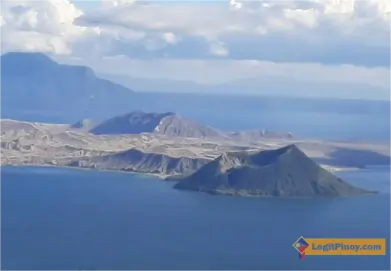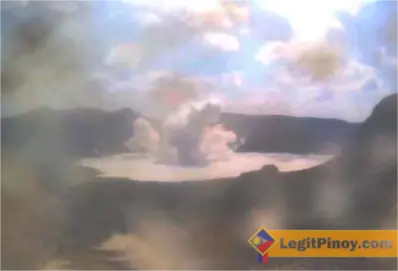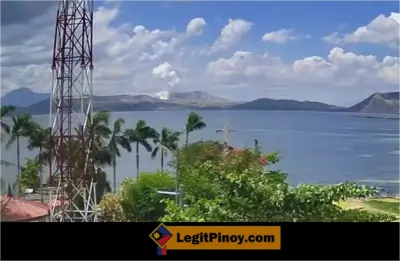Phreatic eruption, 5 volcanic quakes recorded in Taal Volcano

Taal Volcano’s Location and Significance
Taal Volcano, situated on the island of Luzon in the Philippines, holds a significant place in both geological and cultural contexts. Its unique location within a lake, which itself rests within a larger caldera, makes it an intriguing geological feature.
The volcano’s historical eruptions have shaped the surrounding landscape and influenced local communities’ way of life, making it a focal point for scientific study and disaster risk management.
In recent times, Taal Volcano has exhibited signs of increased activity, culminating in a phreatic eruption and a series of volcanic earthquakes.
The eruption, characterized by steam-driven explosions caused by the interaction of groundwater with magma, has prompted concerns about the volcano’s ongoing unrest and potential hazards to nearby populations.
Advertisement

What is a Phreatic Eruption?

A phreatic eruption occurs when groundwater comes into contact with hot magma beneath the surface, leading to rapid vaporization and the expulsion of steam, gases, and volcanic material. Unlike traditional eruptions characterized by lava flows, phreatic eruptions primarily involve explosive release of steam and volcanic gases, often accompanied by ash and rock fragments.
Prior to the phreatic eruption, Taal Volcano experienced a series of volcanic earthquakes, which are seismic events caused by the movement of magma and volcanic fluids beneath the surface. These earthquakes serve as vital precursors to volcanic activity, providing valuable insights into the volcano’s internal processes and indicating increased volcanic unrest.
Monitoring and analyzing seismic events play a crucial role in volcanic hazard assessment and risk mitigation efforts. By studying the frequency, magnitude, and location of earthquakes, scientists can better understand the dynamics of volcanic systems and issue timely warnings to at-risk populations.
Phreatic vs. Traditional Eruptions
Phreatic eruptions differ from traditional volcanic eruptions in their underlying mechanisms and resulting phenomena. While traditional eruptions involve the extrusion of molten lava onto the surface, phreatic eruptions are driven by the explosive release of steam and gases, often without significant magma involvement.
Phreatic eruptions pose various risks to surrounding areas, including the ejection of volcanic ash, rocks, and other debris at high velocities. Ashfall from phreatic eruptions can blanket wide areas, causing respiratory problems, damaging crops and infrastructure, and disrupting daily life for local communities.
The impact of phreatic eruptions extends beyond immediate hazards, affecting the socioeconomic fabric of nearby communities. Displacement of populations, destruction of livelihoods, and disruption of essential services underscore the importance of comprehensive preparedness and response measures.
Historical Context: Taal Volcano’s Previous Activity
The eruption of Taal Volcano in January 2020, characterized by phreatomagmatic explosions and lava fountaining, had significant ramifications for surrounding areas. The eruption prompted mass evacuations, disrupted transportation and commerce, and caused widespread damage to infrastructure and agriculture.
Comparing the recent activity with past eruptions provides valuable insights into Taal Volcano’s eruptive behavior and recurrence patterns. Understanding the volcano’s historical activity helps scientists and disaster managers assess potential hazards and develop effective mitigation strategies.
Taal Volcano’s location in close proximity to densely populated areas presents unique challenges for disaster risk management and urban planning. Balancing the need for sustainable development with the imperative of safeguarding lives and property requires coordinated efforts from various stakeholders and government agencies.
Monitoring and Preparedness Measures
The Philippine Institute of Volcanology and Seismology (PHIVOLCS) plays a pivotal role in monitoring Taal Volcano’s activity and providing timely alerts and advisories to the public. Through a network of monitoring instruments and trained personnel, PHIVOLCS continuously assesses volcanic hazards and communicates risk information to at-risk communities. PHIVOLCS issues advisories and warnings to residents living near Taal Volcano, urging them to stay informed, prepare evacuation plans, and heed evacuation orders when necessary.
Public awareness campaigns and community engagement initiatives enhance residents’ understanding of volcanic hazards and foster a culture of resilience. In anticipation of volcanic activity, precautionary measures such as the distribution of face masks, provision of emergency shelters, and evacuation drills are implemented to mitigate risks and ensure public safety. Collaboration between government agencies, non-governmental organizations, and local communities is essential for effective preparedness and response efforts.

Advertisement

Conclusion
As Taal Volcano continues to exhibit signs of unrest, ongoing monitoring and preparedness efforts remain critical for mitigating potential hazards and protecting vulnerable populations.
The events at Taal Volcano underscore the importance of continuous monitoring and scientific research in volcanic-prone regions, enabling proactive risk management and disaster preparedness.
Despite the inherent uncertainties associated with volcanic activity, efforts to assess and mitigate risks are ongoing, reflecting a commitment to safeguarding lives, livelihoods, and the environment from volcanic hazards.
We may also recommend:
You may also read the following:
- Wow888
- betso88
- bk8
- Majesty33
- Okebet168
- lodi291
- Phl63
- JiliCC
- jlbet
- phjoy
- phwin
- slotvip
- panalobet
- mnl63
- 10jili
- ok777 win
- jili22
- Lucky777 Casino
- lodigame
- Peso888
- intgames
- 22win
- milyon88
- ME777
- luckyjackpot888
- MNL777
- YY777
- SuperPH
- FC777
- JILIHOT
- Big Baller Club
- JILIPLAY
- MWPLAY888
- Playzone
- S5 Casino
You may also like:

Jillian Cruz is a versatile blogger and content writer known for her curiosity and passion for writing about various topics. Her engaging writing style attracts readers from all backgrounds. She also collaborates with brands and publications, bringing her unique perspective to marketing campaigns and articles. With her creativity and dedication, Jillian continues to make an impact in the world of blogging and content creation.
